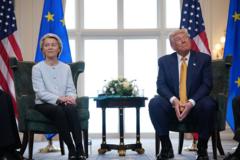Leaders from across Europe are expressing growing dissatisfaction with the recent EU-US trade agreement, heralded by European Commission chief Ursula von der Leyen and US President Donald Trump as a breakthrough after lengthy negotiations. Although the deal came just before Trump’s self-imposed deadline of August 1, many European nations are now focusing on the substantial tariffs set to impact several key industries.
While the announcement of a 15% tariff was seen as a victory compared to the potential 30% hikes previously threatened by Trump, the new rate represents a considerable increase from the historical average of just 4.8%. Germany's finance minister, Lars Klingbeil, expressed disappointment over the terms but acknowledged the necessity to avoid further escalations in trade tensions.
Despite these sentiments, the finer details of the agreement have yet to be clarified. While the EU Commission maintains that the deal is a political framework and not legally binding, the US administration portrays it as a historic reform. The discrepancies in interpretation surrounding the agreement raise concerns among EU officials about its long-term implications.
Trade agreements typically require extensive bilateral negotiations lasting up to 24 months, and analysts like Cinzia Alcidi from the Centre for European Policy Studies in Brussels project that uncertainty will persist as talks continue. The immediate imposition of the blanket 15% tariff serves to provide some industry clarity, yet further negotiations are essential to redefine terms for key goods such as pharmaceuticals and semiconductors.
Proposals by the US regarding quantitative commitments towards US energy products and military spending are met with skepticism from the EU, which emphasizes that future procurement depends largely on the decisions of private companies rather than governmental mandates. Some of these discrepancies could complicate the dynamics of the EU-US relationship moving forward.
The impact of the tariffs is expected to vary by country, with Germany, Ireland, and Italy among the most disadvantaged. Germany's automotive industry, heavily reliant on US exports, faces potentially stark financial penalties, while Ireland's dependence on pharmaceutical exports has sparked concern amongst officials there. Italy anticipates negative repercussions across several sectors, forecasting a minimal GDP decline tied to the trade agreement.
As European policymakers navigate the fallout from the deal, leaders reiterate the importance of a unified stance in further negotiations, with French President Emmanuel Macron urging for a more assertive approach towards the US, reflecting widespread unease among nations that feel cornered by the latest arrangement with Trump’s administration. The path ahead remains fraught with challenges, and many view the current deal as merely a preliminary step in a much longer negotiation process.






















